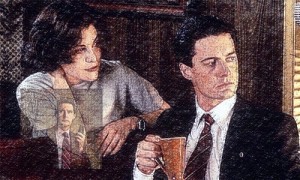Dale Bartholomew Cooper is a fictional character, an eccentric Special Agent of the FBI. Cooper was the central figure of the ABC television series “Twin Peaks”, and was played by actor Kyle MacLachlan.
The series was created by legendary film director David Lynch and Mark Frost, and went on to achieve a cult status of its own.
The Man, and His Methods
David Lynch named Cooper as a reference to D. B. Cooper, the unidentified man who hijacked a Boeing 727 aircraft on November 24, 1971. Cooper escaped by parachute, never to be seen, again.
Born on April 19, 1954, the fictional Dale Cooper is a graduate of Haverford College. After joining the Federal Bureau of Investigation (FBI), Cooper was based at the Bureau offices in Philadelphia, Pennsylvania. He was partnered there with the older Special Agent Windom Earle (actor Kenneth Welsh) – a closet psychopath whose various crimes (when they came to light) would return to haunt Cooper, in later years.
Key among these was the case of Earle’s wife, Caroline, who witnessed a federal crime, some time after Cooper joined the Bureau. Earle and Cooper were assigned to protect her; it was around this time that Cooper began an affair with Caroline. One night in Pittsburgh, Cooper let his guard down – and Caroline was murdered by her husband (who had also committed the crime witnessed by Caroline, during a psychotic break). Windom Earle was subsequently sent to a mental institution, from which he would later escape, to wreak havoc in Twin Peaks.
Cooper was devastated by the loss of the woman he would later refer to as the love of his life. He swore to never again become involved with someone who was part of a case to which he was assigned.
An introspective man, Cooper is fueled by a profound interest in the mystical, especially the mythology of Tibetan and Native American cultures. Much of his work is based on intuition and the interpretation of dreams, rather than conventional logic. While working a case, Cooper also dictates regular reports to his (never seen) assistant Diane, using a hand-held tape recorder.
“A hairless mouse with a pitchfork sang a song about caves.”
Okay, this is actually a quote from the “Twin Peaks” parody sketch when Kyle Maclachlan guest hosted Saturday Night Live in 1990. But the fact that it’s not a million miles from the kind of stuff Dale Cooper puts out during his “real” adventures gives an indication of the methods of the man.
At some point in his career, Cooper was placed under the direct authority of FBI Regional Bureau Chief Gordon Cole (played in the series by David Lynch, himself). Under Cole’s mandate, Cooper was occasionally assigned the mysterious ‘Blue Rose’ cases.
The Town, and Its People
On February 24, 1989, Cooper arrives in the fictional Northwestern town of Twin Peaks, to investigate the murder of local teenager Laura Palmer (actress Sheryl Lee). Here’s a YouTube clip, of Dale’s arrival, from the series’ pilot episode:
It’s a complex case, involving the town’s eccentric characters (like The Log Lady), metaphysical entities, and other-dimensional spaces like the mysterious Black Lodge. During his extended stay, Cooper winds up helping the Twin Peaks Sheriff’s Department to investigate other cases, as well.
Cooper gains an instant rapport with many of the townspeople – including Sheriff Harry S. Truman (yes, like the President; actor Michael Ontkean) and his junior officers, Deputy Tommy “Hawk” Hill and Deputy Andy Brennan. 18-year-old Audrey Horne (played by Sherilyn Fenn), the daughter of local businessman Benjamin Horne, develops a serious crush on the eccentric FBI man. Over time, a close and affectionate friendship develops, between the two.
And Cooper falls in love with the “damn fine coffee”, and cherry pie, for which the town would become famous. Check out the YouTube clip below, to get a flavor of the place:
The Laura Palmer mystery is eventually “resolved” on an ambiguous note, with Dale Cooper’s evil doppelganger on the loose in Twin Peaks (a fugitive from the Black Lodge; watch the show on DVD, it’s too complex to go into, now), and the dead girl’s spirit vowing that “I’ll see you again in 25 years.”
His Anticipated Return
Now, 25 years on, that promise is to be fulfilled. In 2016, Showtime will be bringing us a sequel to the cult series. The network says that nine new “Twin Peaks” episodes – set in the present day – are going into production soon. And Kyle MacLachlan is set to return, as Dale Cooper – as are several other characters from the original 1990s run.
Showtime’s president, David Nevins, has even persuaded David Lynch to direct all nine episodes.
Fans will no doubt be hoping that the sequel will answer the questions left hanging at the end of season two in 1991. Nevins is keeping quiet on this.
Only time will tell.
Keep watching this space.
Peace.










